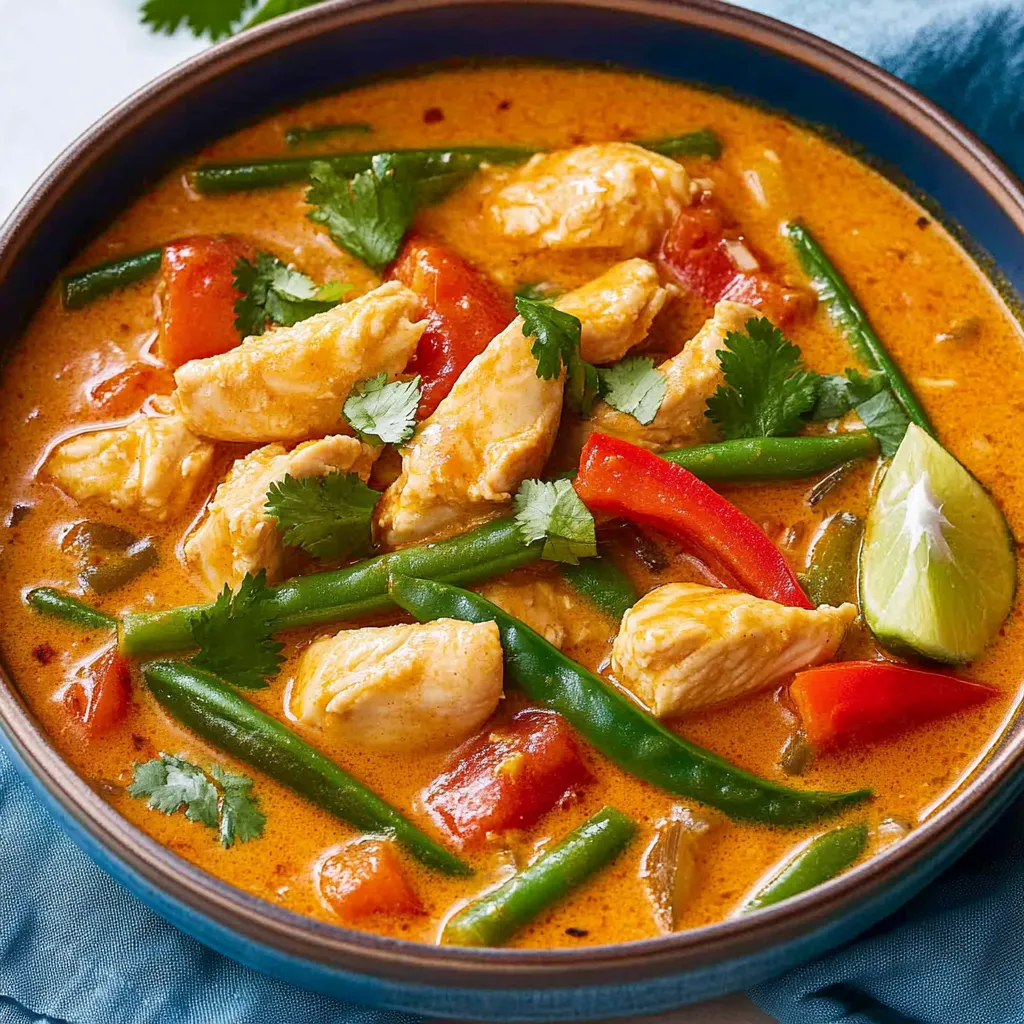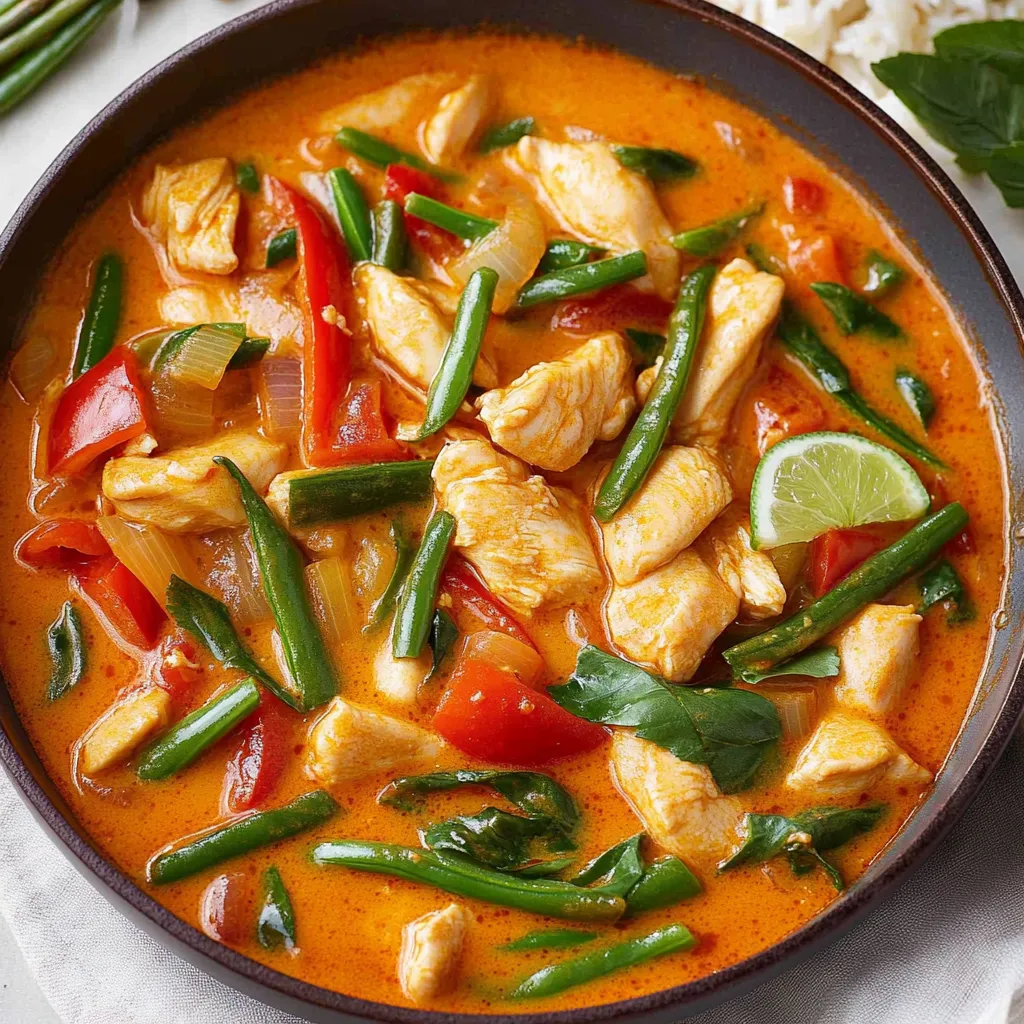 Pin it
Pin it
This Thai red curry transforms simple ingredients into a rich, aromatic dish that tastes like it's been simmering all day, though it comes together in just 30 minutes. The perfect balance of spicy, sweet, and savory flavors wrapped in creamy coconut milk creates a restaurant-quality meal right in your own kitchen.
I discovered this curry recipe during a busy week when I needed something quick but didn't want to sacrifice flavor. My family was skeptical about homemade Thai food, thinking it would be complicated or not taste authentic. Their doubts vanished with the first bite – my teenager, who typically pushes vegetables around on his plate, actually asked for seconds and specifically mentioned how good the sauce was with the rice.
Ingredients
- Chicken thighs – These stay tender and juicy in the simmering sauce, absorbing all the aromatic flavors without drying out. Their slightly higher fat content adds richness to the final dish.
- Onion, garlic, and ginger – This aromatic trinity forms the flavor foundation, releasing their essential oils to infuse the entire dish with warmth and depth. Fresh ingredients make a noticeable difference here.
- Red curry paste – The concentrated blend of chilis, lemongrass, galangal, and spices provides authentic Thai flavor without requiring dozens of individual ingredients. Different brands vary in heat level, so adjust accordingly.
- Coconut milk – Full-fat canned coconut milk creates that signature creamy, rich sauce that balances the heat from the curry paste. Its subtle sweetness rounds out the spicy and savory elements.
- Fish sauce – This umami-rich ingredient might smell potent in the bottle, but it transforms in cooking, adding incredible depth without any fishiness. It's the secret to authentic Thai flavor.
- Light brown sugar – Just a touch enhances the natural sweetness of the coconut milk and balances the heat from the curry paste. This subtle sweetness is essential to achieving that perfect Thai flavor balance.
- Green beans and red bell pepper – These vegetables maintain their texture during cooking, adding freshness, color, and nutrition to the rich sauce. Their mild flavors absorb the curry beautifully.
- Thai basil – Added at the end, these aromatic leaves add a fresh, slightly anise-like flavor that's distinctly Thai. Regular basil works if Thai basil is unavailable, though the flavor profile will be slightly different.
- Lime juice – This final bright note cuts through the richness of the coconut milk and rounds out all the flavors, bringing everything into perfect balance.
Step-by-Step Instructions
- Brown the chicken –
- Heat a tablespoon of oil in a large skillet over medium-high heat. Add chicken pieces in a single layer, being careful not to overcrowd the pan. Cook for about 2-3 minutes per side until golden but not fully cooked through. This step creates flavor through caramelization while sealing in juices.
- Remove and reserve chicken –
- Using a slotted spoon, transfer the partially cooked chicken to a plate and set aside. Don't worry about it being undercooked – it will finish in the sauce later, absorbing all those wonderful flavors.
- Sauté the aromatics –
- In the same pan with the flavorful chicken bits, add diced onion, minced garlic, and grated ginger. Sauté for about a minute until fragrant and slightly softened. The aromatics will pick up the savory fond left from browning the chicken.
- Bloom the curry paste –
- Add the red curry paste to the aromatics and cook for about a minute, stirring constantly. This critical step activates the essential oils in the spices, intensifying their flavors and aromas throughout the dish.
- Create the sauce base –
- Pour in the coconut milk and stir until the curry paste is fully incorporated. The sauce should take on a beautiful orange-red hue as the ingredients come together.
- Add depth and balance –
- Stir in the fish sauce and brown sugar, bringing the sauce to a gentle simmer. Taste and adjust seasonings if needed – this is your opportunity to customize the heat and flavor balance.
- Return chicken to the pan –
- Add the browned chicken pieces back to the simmering sauce, ensuring they're submerged to absorb maximum flavor as they finish cooking.
- Add vegetables –
- Stir in the chopped green beans and sliced red bell pepper. These go in later to maintain their texture and vibrant color. Cover and simmer for about 8 minutes until the chicken is cooked through and vegetables are tender-crisp.
- Finish with fresh elements –
- Remove from heat and stir in the torn Thai basil leaves and fresh lime juice. These final additions bring brightness and freshness to balance the rich, cooked flavors of the curry.
- Serve immediately –
- Ladle the curry over steaming jasmine rice, ensuring each serving gets plenty of the flavorful sauce. The rice acts as the perfect canvas to soak up every last drop.
 Pin it
Pin it
The transformation that happens as the ingredients simmer together is remarkable – what begins as separate components melds into a cohesive, complex sauce with layers of flavor. The coconut milk mellows the heat of the curry paste while the fish sauce and aromatics create depth that makes this quick-cooking dish taste like it's been simmering for hours.
My grandmother always said a good curry should have a perfect balance of hot, sour, salty, and sweet elements. The first time I made this dish, those words echoed in my mind as I tasted and adjusted each component. That attention to balance transformed what could have been just another weeknight dinner into something memorable that now appears regularly in our meal rotation.
Finding Your Perfect Spice Level
The beauty of making curry at home is controlling exactly how spicy the final dish will be. If you're new to Thai curries, start with just 1-2 tablespoons of curry paste, then taste the sauce after adding the coconut milk. You can always stir in more paste for additional heat, but you can't take it away once it's there. For those who enjoy extra spice, a sliced fresh red chili added with the vegetables will give an extra kick.
Creating Layers of Flavor
What distinguishes an exceptional curry from a merely good one is the layering of flavors at different stages of cooking. Browning the chicken creates one dimension, blooming the curry paste in oil releases aromatic compounds, simmering develops depth, and the final additions of herbs and lime juice bring brightness. Each element plays a crucial role in the complex final flavor.
Making It Your Own
The versatility of this curry makes it perfect for using whatever you have on hand. Firm vegetables like carrots or potatoes should be added earlier in the cooking process, while quicker-cooking ones like snow peas or spinach can be stirred in during the final few minutes. For a vegetarian version, replace the chicken with cubed firm tofu and use soy sauce instead of fish sauce.
I've prepared this curry countless times over the years, gradually refining the process to maximize flavor while minimizing effort. What continues to amaze me is how something so quick to prepare can develop such remarkable depth of flavor. There's something deeply satisfying about setting a steaming bowl of fragrant curry on the table after a long day, watching faces light up at the aroma alone. This dish has become more than just a meal in our household – it's a reminder that nourishing food doesn't have to be time-consuming or complicated to be extraordinary.
Frequently Asked Questions
- → Can I use a different protein instead of chicken?
- Yes! This curry works great with shrimp, tofu, or thinly sliced beef. Just adjust cooking times accordingly - shrimp needs only 2-3 minutes, tofu about 5 minutes, and beef similar to chicken.
- → What can I substitute for fish sauce?
- For a vegetarian option, use soy sauce or tamari with a squeeze of lime juice. You can also try store-bought vegetarian fish sauce alternatives.
- → Can I make this curry ahead of time?
- Yes, this curry tastes even better the next day! Store it in the fridge for up to 3 days and reheat gently on the stove or microwave.
- → What vegetables work best in this curry?
- Besides bell peppers and green beans, try broccoli, snap peas, carrots, zucchini, or bamboo shoots. Any quick-cooking vegetable works well.
- → Is this curry spicy?
- The spice level depends on your curry paste. Start with less paste if you prefer mild curry, or add a chopped Thai chili or sriracha for extra heat.
- → What's the best rice to serve with Thai curry?
- Jasmine rice is traditional and works beautifully. Basmati rice is also good, or try cauliflower rice for a low-carb option.
